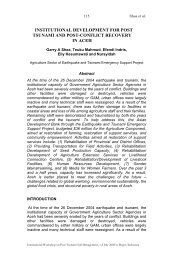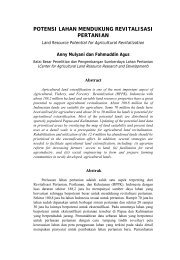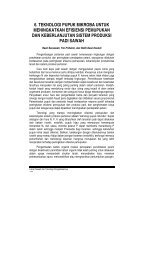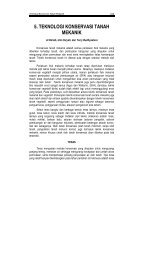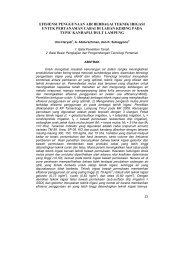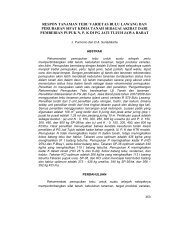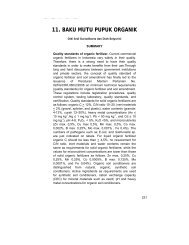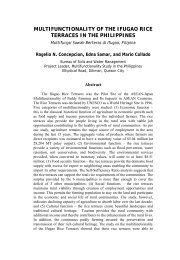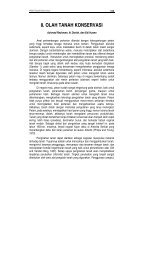Proceedings - Balai Penelitian Tanah
Proceedings - Balai Penelitian Tanah
Proceedings - Balai Penelitian Tanah
You also want an ePaper? Increase the reach of your titles
YUMPU automatically turns print PDFs into web optimized ePapers that Google loves.
International Workshop on Post Tsunami Soil Management, 1-2 July 2008 in Bogor, Indonesia<br />
69<br />
Agus F<br />
determining factor of the decomposition rate. Although uncertain of<br />
the accuracy, based on empirical relationship from green house gas<br />
emission research, Hooijer et al. (2006) suggested that the emissions<br />
rate increases 0.91 t CO2 ha -1 with one cm drainage depth increase.<br />
Our assumed values for the average drainage depths for<br />
vegetable/maize, paddy rice system, rubber and oil palm are 30, 10,<br />
20 and 60 cm, respectively.<br />
Sa is sequestration in the above ground plant biomass and this<br />
amount equals the time average above ground C stock in the<br />
alternative land use (t/ha)* 3.67. Oil palm and rubber sequestrate as<br />
much as 60 and 56 t C ha -1 (IPCC, 2003; Rogi 2002)<br />
Based on these assumptions Figure 1 shows annual average CO2<br />
emissions when peat forest is converted to various agricultural land<br />
uses. It must be understood that the Sa and Ebo components of the<br />
emissions occurred only during the land clearing process while the<br />
rest occurs during the cultivation stage.<br />
CO2 emissions (t/ha/yr)<br />
100.0<br />
80.0<br />
60.0<br />
40.0<br />
20.0<br />
0.0<br />
-20.0<br />
Sa<br />
Ebo<br />
Ebc<br />
Ebd<br />
Ea<br />
Maize/vegetable Paddy rice Rubber Oil palm<br />
Alternative land uses<br />
Figure 1. Annual average CO2 emissions estimates from peat forest<br />
conversion to various agricultural land uses. Time average<br />
was based on 25 year crop cycle(s)<br />
Vegetable production on peat soil emits the highest amount of CO2 and<br />
the highest contributor to the emissions is peat burning for soil fertility<br />
improvement. The area cultivated by each household for the traditional<br />
farming is only a couple of ha and scattered but this practice depletes<br />
the peat layer and causes subsidence and emissions. Peat<br />
decomposition from vegetable cultivation areas is also relatively high.<br />
Oil palm is believed to emit the highest amount of CO2 among estate<br />
crops due to the deep drainage. Our assumption of 60 cm average<br />
drainage depth may be considered as the lowest limit since in some



